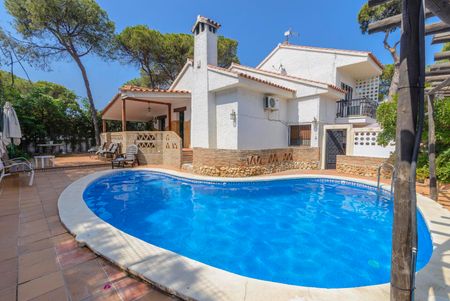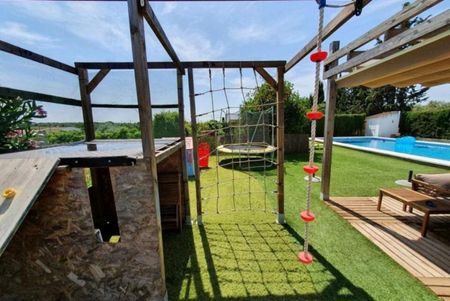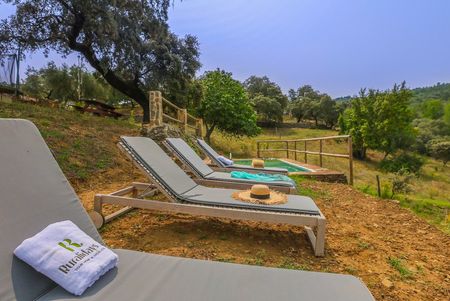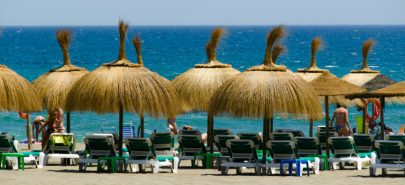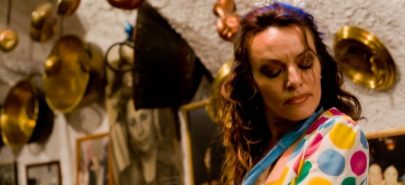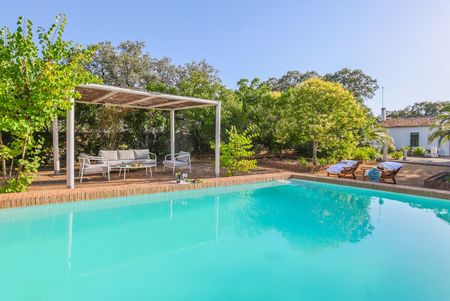Discover which the Lugares Colombinos are in Huelva, thanks to Ruralidays, and visit the Columbian Sites where Christopher Columbus planned his trip.
You might have already heard about the Lugares Colombinos in Huelva, i.e.the places in Huelva where Christopher Columbus prepared his journey to the Indias, which ended up discovering America. Precisely named after the Genoan discoverer, these places are known to be part of the Columbus route.
Both in the 1492 journey and the following trips, Huelva and its province were the areas that provide the most to the discoverer, and from where the ships set sail on the way of the New World.
Below, you can find a list of the Lugares Colombinos in Huelva; you will discover what you can see in each of the suggested stops so that you won’t miss out on the charms of Huelva and its province.
Where are the Lugares Colombinos?
The route that’s inspired by Christopher Columbus as the discoverer of America mainly comprehends the towns of Moguer and Palos de la Frontera (which includes the area of La Rábida) and Huelva city. These three areas feature a high quantity of emblematic monuments that are related to Columbus and the other navigators’ preparation of the journeys to America. The Lugares Colombinos are located near Punta Umbría and the marshlands of river Odiel; therefore, the Columbus route does have not only an historical importance but also a geographical one, thanks to the splendid landscapes that envelops it.
How to move along the Ruta Colombina?
First of all, you will have to determine when and how you’re going to do the Ruta Colombina, meaning which transport you are going to use. We suggest you double-check the opening hours of the monuments and you take note of the hours of light in Huelva and its province year-round. So, in winter, you’d better set the departure and arrival hour so that you can visit all the open-air tourist places.
Columbus route by car
The best way to enjoy the Columbian sites and organise oneself freely is by travelling by car. Either if you go with your own vehicle, or you rent one, to visit this area of Andalucia will be much easier this way.
Leaving from Seville, you can get to Moguer in one hour (89 km), by taking the A-49 highway towards Camas/Huelva, then taking the exit number 75 that leads to the A-494 road and following the indications for Moguer. Likewise, you can start your route from Huelva, which is only 93 km from Seville.
Moguer and Palos de la Frontera are 11 km from one another, and 5.5 km separate the latter from La Rábida area.
Columbus route by bus
If you don’t have a car at your disposal, moving around by bus might be a good alternative. In this case, we recommend you start the route from Huelva.
The capital city is connected to Seville via an excellent bus service, provided by the Damas bus company (€8.91 for a journey that is 75-120 minutes long, depending on the hour and date you choose to travel).
Once in Huelva, you can move around with the Damas company, which provides service to Huelva and Moguer (€1.75 for a 40-minute trip), Palos de la Frontera (€1.75 for a half-an-hour journey), and La Rábida (€1.75 for a 20-minute trip). The same company offers this service between these three areas so that you can visit the Lugares Colombinos without a car (ticket is €1.40).
The Lugares Colombinos in Moguer
Moguer is one of the most notable towns among those related to Columbus, thanks to the presence of the Monastery of Santa Clara and the port of Moguer, where one of the caravels was built.
1. The Monastery of Santa Clara
The 14th-century Monastery of Santa Clara belonged to Inés Enríquez, aunt of King Ferdinand the Catholic. This Monastery stands out for featuring Andalucia’s oldest conventual cloister, the Cloister of the Mothers, and for its 16th-century Renaissance-style infirmary. Besides, the church features an impressive major altar, where you can admire a carved altarpiece and a choir that welcomes Spain’s only perfectly-maintained Nasrid set of chairs.
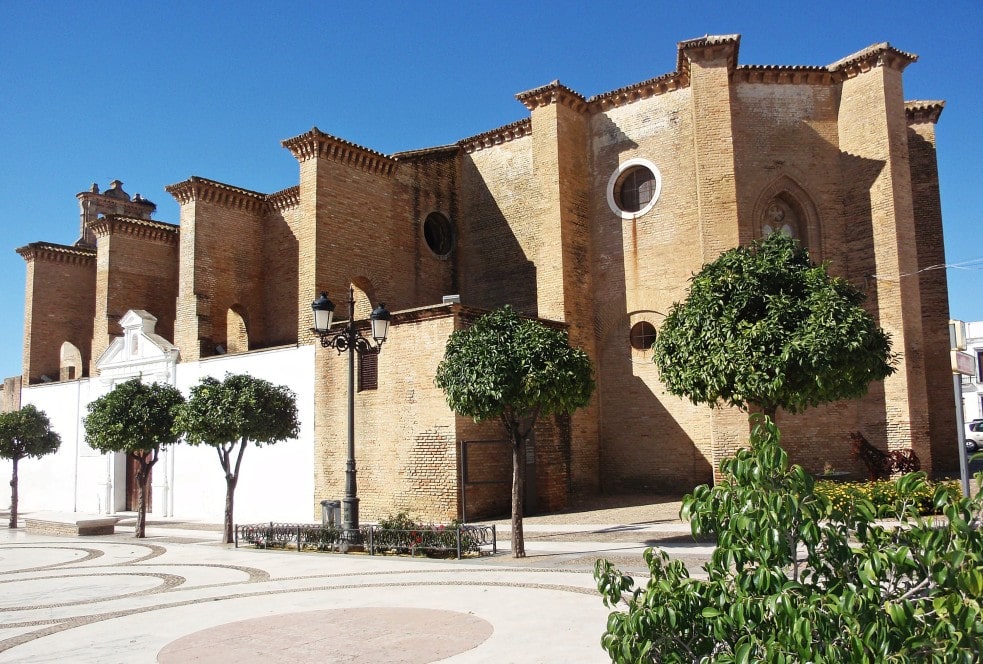
The Monastery’s appearance among the Lugares Colombinos is because Columbus prayed here on the night of March 16th, 1493, after taking a vow (the Voto Colombino) when the caravel on which he was travelling back from America, had been about to shipwreck.
- From September 16th to June 13th:
- From Tuesday to Saturday: 10.30 am, 11.30 am, 12.30 pm, 4.30 pm, 5.30 pm and 6.30 pm
- Sunday: 10.30 am and 11.30 am
- Closed: Mondays
- From June 14th to September 15th:
- Tuesday, Wednesday, Friday, and Saturday: 10.30 am, 11.30 am, 12.30 pm, 5.30 pm and 6.30 pm
- Thursdays: 10.30 am, 11.30 am, 12.30 pm, 9 pm, 10 pm and 11 pm
- Sunday: 10.30 am and 11.30 am
- Closed: Mondays and Festive days
- Adults: €3.50
- Students and retired people: €2.50
- Families (parents with at least one minor): €9
- Groups of at least 20 people: €2.50/person.
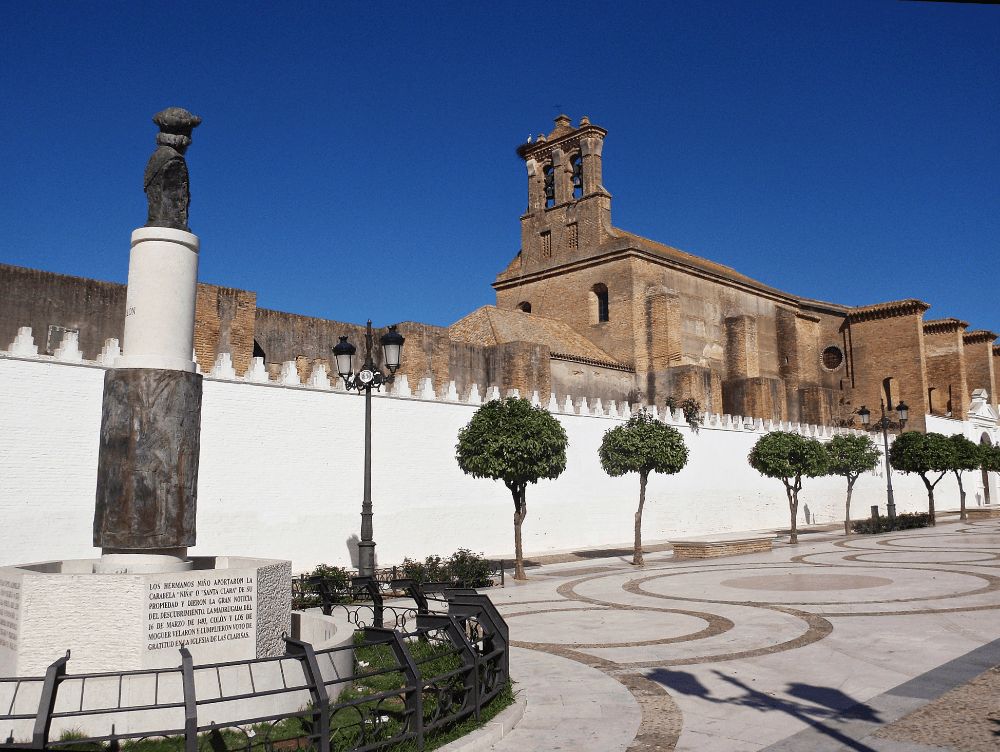
Besides, near the Monastery, you can spot the Monumento a Colón. The bust of the discoverer is slightly rotated towards the left, towards the Monastery of Santa Clara. In the column of the monument, which was erected in the 514th anniversary of the departure of the expedition, you can admire four scenes relating the relationship between Columbus and the town of Moguer.
- Columbus left his son Diego with the inhabitants of the town, in particular in the care of Juan Rodríguez Cabezudo
- Conversation between Columbus and the Niño brothers, who provided La Niña caravel to the expedition.
- Boarding of Columbus and the sailors onto La Niña
- Voto Colombino (Columbus’ Vow), which Columbus took by praying in the Monastery of Santa Clara after coming back from the Americas.
2. Port of Moguer
The other important point of Moguer is the old Port of La Ribera, where La Niña caravel was built. The construction of the caravel dates back to 1488, although it was only used for the first time in the 1492 journey.
The Lugares Colombinos in Palos de la Frontera
Palos de la Frontera is considered to be the Cradle of the Discovery of America.
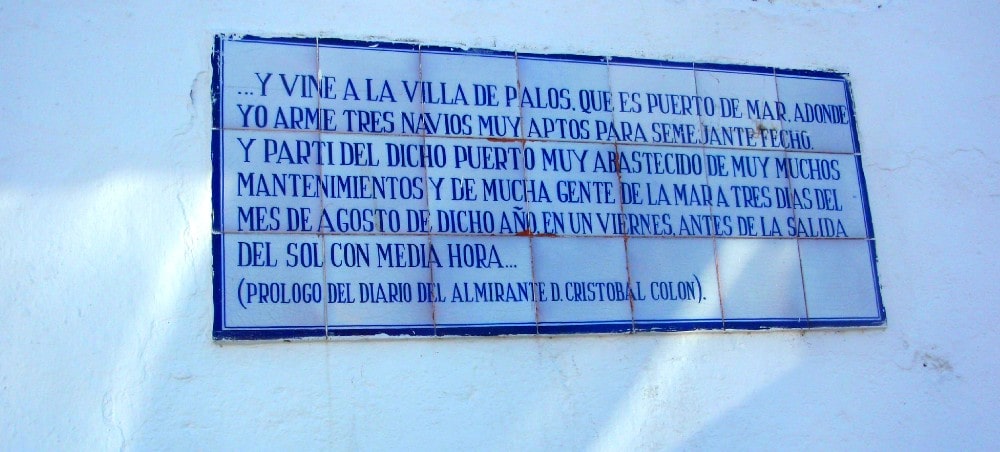
3. Casa-Museo de Martín Alonso Pinzón
It’s the birthplace of the Pinzón brothers, who, together with Columbus, had a fundamental role in the journey that led to the discovery of America. The house of the three brothers (Martín Alonso, Vicente Yáñez and Francisco Martín), which still keeps the original 15th-century façade, has been converted into a museum that displays documents and objects related to the Pinzón brothers and the Discovery of America.
- Adults: €1
- Students, retired people and groups: €0.50
4. Iglesia de San Jorge
This 14th-century, Gothic-Mudejar church is related to Christopher Columbus because in its square, the Real Pragmática was read in May 1492. The royal decree ordered the provision of two caravels to Columbus, as well as the recruitment of the sailors for the journey. Besides, the Puerta de Los Novios (the Spouses’ Door), in the backside of the church, is where the sailors left from, to set sail in the early hours of August 3rd, 1492.
5. Muelle de las Carabelas
Palos de la Frontera is especially crucial for the journeys of Columbus because from its port the three caravels (La Niña, La Pinta and La Santa María) left for the Indias, at the beginning of August 1492.
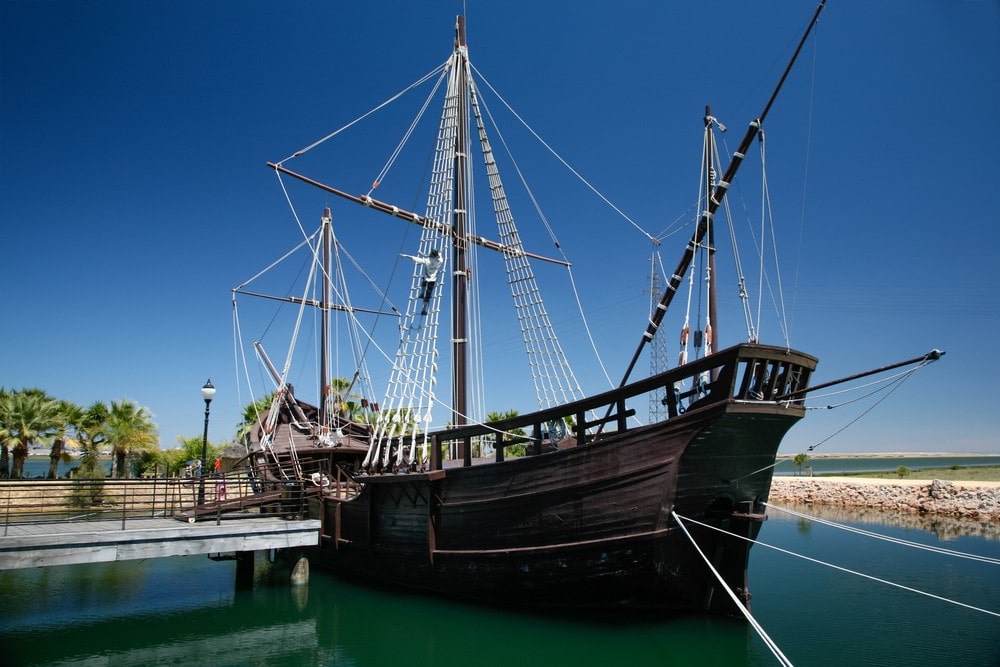
Specifically, the Muelle de las Carabelas, located near the area of La Rábida, is a real open-air museum of the journeys of Christopher Columbus. In the inner harbour (around which a typical Middle-age neighbourhood is built), you can visit actual-size replicas of the three caravels. The models were built in 1992, for the Fifth Centenary of the Discovery of America.
The Muelle de las Carabelas also features a Visitors’ Centre, with a 120-place hall where a video about the journey to the Indias is displayed, as well as the Isla del Encuentro (the Meeting Island), where the indigenous culture is recreated, which the first navigators would find upon arriving at the Guanahani Island.
- From June 16th to September 15th:
- From Tuesday to Sunday: 10 am – 9 pm
- Doors close at 8 pm
- From September 16th to June 15th:
- From Tuesday to Sunday: 9.30 am – 7.30 pm
- Closed on Mondays
- Adults: €3.60
- Students, retired people and groups (at least 20 people): €1.50
- Families (couples with at least one minor): €7.50
- Children less than five years old: free
You can buy tickets online by clicking here
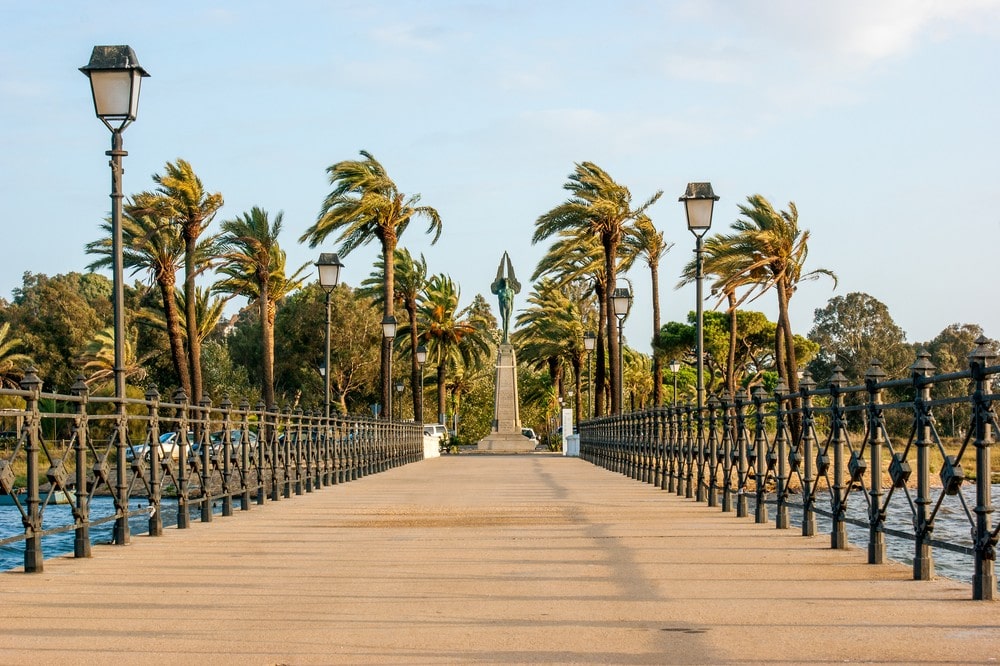
6. Monasterio de La Rábida
In Palos de la Frontera, you will also find the Monastery of La Rábida, whose fundamental role is renowned in the Discovery of America. The Gothic-and-Mudejar- style Monastery dates back to the 14th and 15th centuries, and it was the third Spanish monument being declared a National Monument, in 1856.
Here is where Columbus stayed before leaving for the Indias, when he was still planning the expedition and after the Portuguese king had rejected his proposal. What has particular importance is Columbus’ relationship with Fray Juan Pérez, who helped him negotiate with the Crown of Castile and support him in his petition to the Catholic Monarchs.
In the Monastery, don’t miss out on the Mudejar-style cloister, where Columbus related the details of his journey to the Fray, the image of the Virgen de Los Milagros, which Columbus prayed to before the expedition, and the precious, 15th-century frescos, masterpieces of the painter Daniel Vázquez Díaz. The “Poemas del Descubrimiento” (the Discovery Poems) are distributed in five panels and represent various episodes of Columbus’ journey.
Closed: Mondays, December 24th, 25th and 31st, January 1st, 5th and 6th
- Adults: €3.50
- Students and retired people: €3
- Families (parents with minors): €8
- Groups of at least 20 people: €2 per person
- Minors less than 5 years old: free
- Audioguide available in English, Spanish, Portuguese, French, German and Italian.
7. Parque Botánico José Celestino Mutis
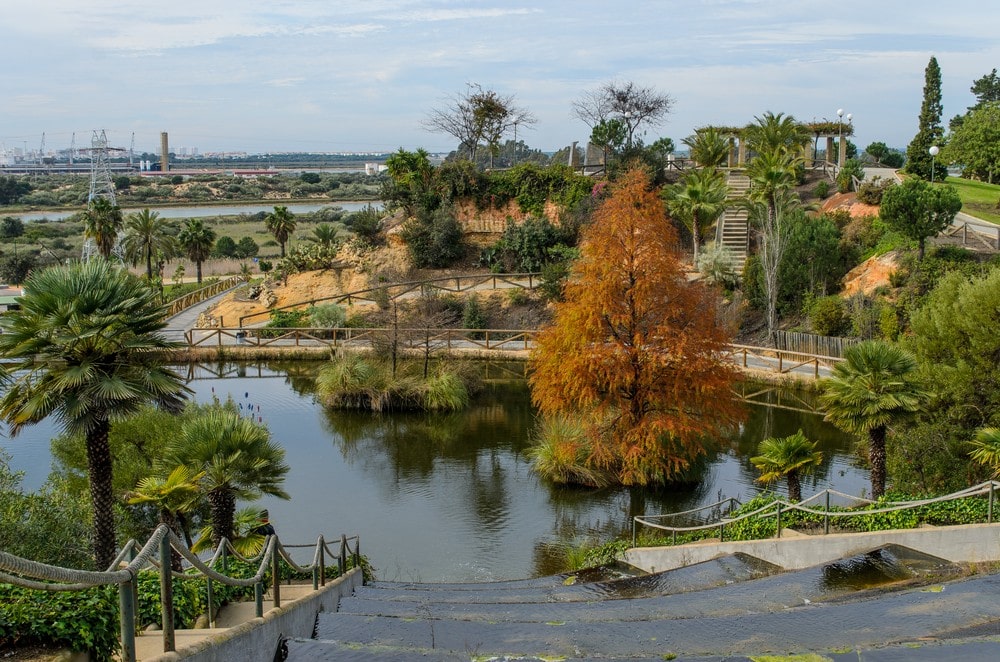
Another one of the Lugares Colombinos in Palos de la Frontera is the Botanical Garden “José Celestino Mutis”, which is named after the homonym botanist from Cadiz. The 12-hectare garden is located near the Monastery of La Rábida, and it was built on the fifth centenary of Columbus’ journey, i.e. in 1993, to seal the union between Spain and America.
The garden welcomes plants from the five continents, a lake with carps and a big greenhouse, in which you can stroll in a real tropical forest.
- From September 16th to June 15th:
- From Tuesday to Sunday: 9.30 am – 7.30 pm
- Doors close at 8 pm
- From June 16th to September 15th:
- From Tuesday to Sunday: 10 am – 9 pm
- Doors close at 9.30 pm
- Closed on Mondays
The Lugares Colombinos in Huelva
8. Monumento a Colón
The last stop of the Columbus’ route is located on the outskirts of Huelva, where you will find the Monument to Columbus. This 37-mt-high statue is set in the Punta del Sebo, on the opposite side of river Tinto from the Monastery of La Rábida.
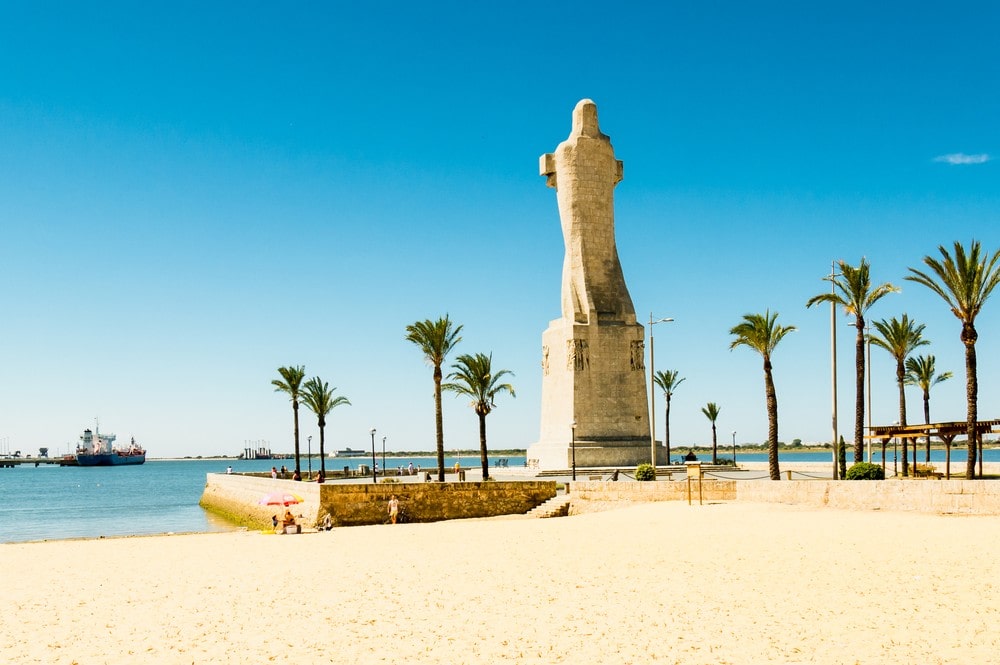
The statue, which was built by the American sculpture Gertrude Vanderbilt Whitney, is a homage from the USA (specifically, of the Columbus Memorial Fund foundation) to the Spanish people. It was homaged in 1929, as the Americans believed it necessary for a homage to Christopher Columbus to be located in the Lugares Colombinos. This need came in place also because of the inevitable deterioration of the Commemorative Column of the Fifth Centenary of the Discovery of America, located in La Rabida.
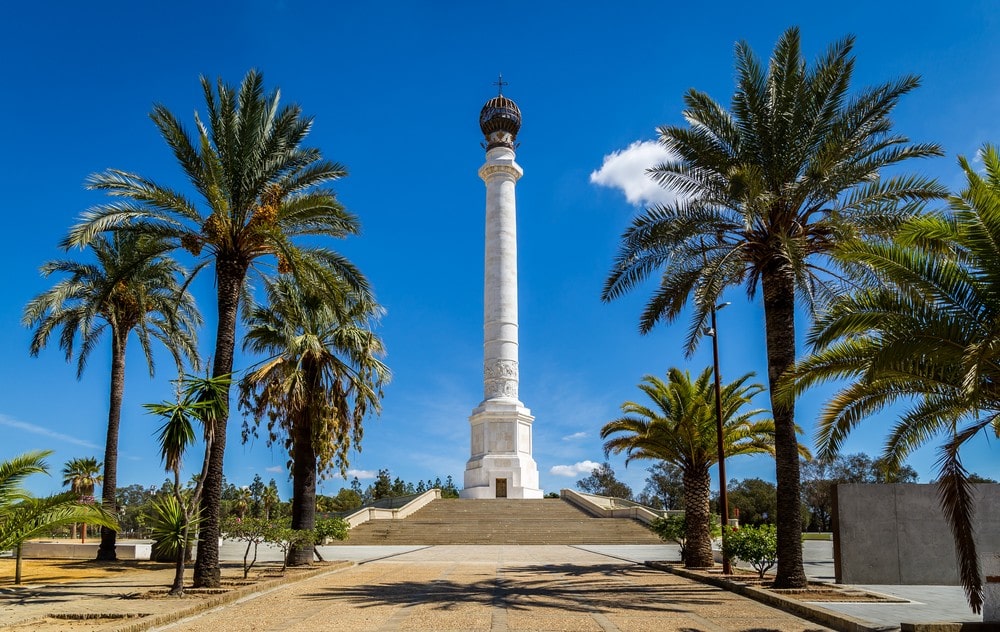
The statue represents a person that leans on a cross. In the pedestal, one can observe a low relief that, according to some interpretation, might represent the Aztec, Inca, Mayan and Christian cultures. However, another possible explanation is that these symbolise the Asian, African, European and American continents.
Besides, inside the pedestal, the names of all those that contribute to the Discovery of America are written, which include the navigators and the Catholic Monarchs.
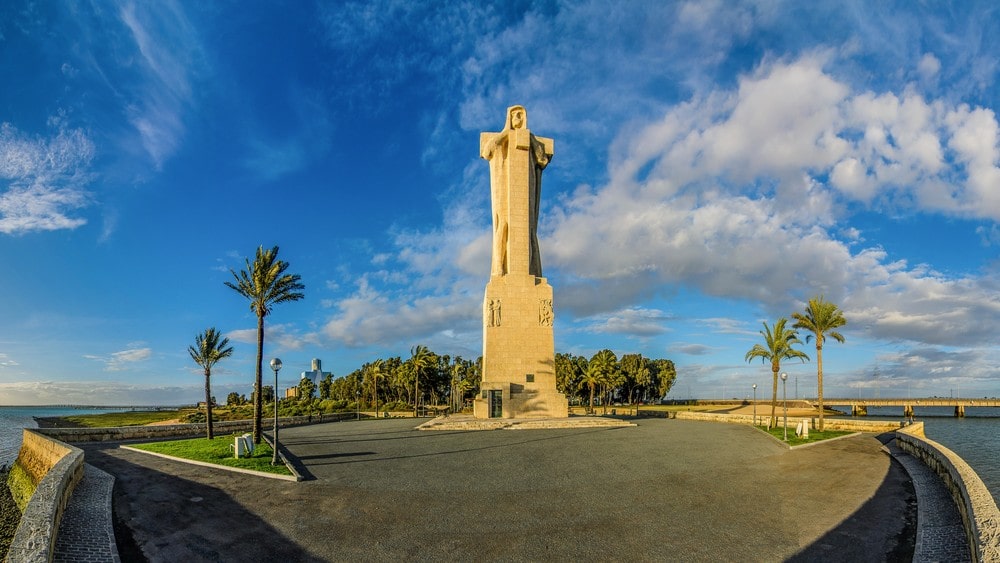
*Disclaimer: the opening hours and prices displayed in this post are verified at the time of publication of the post. We suggest you check the opening hours and prices before planning the Ruta Colombina.
Your holiday home in Huelva
To enjoy the Lugares Colombinos and make the most of the Ruta Colombina, you can accommodate in one of our holiday homes in the province of Huelva. You will find all the comforts that you could need, and you will have the Lugares Colombinos within a stone’s throw; you will then be able to jump back in time by visiting the same places where Christopher Columbus lived.
